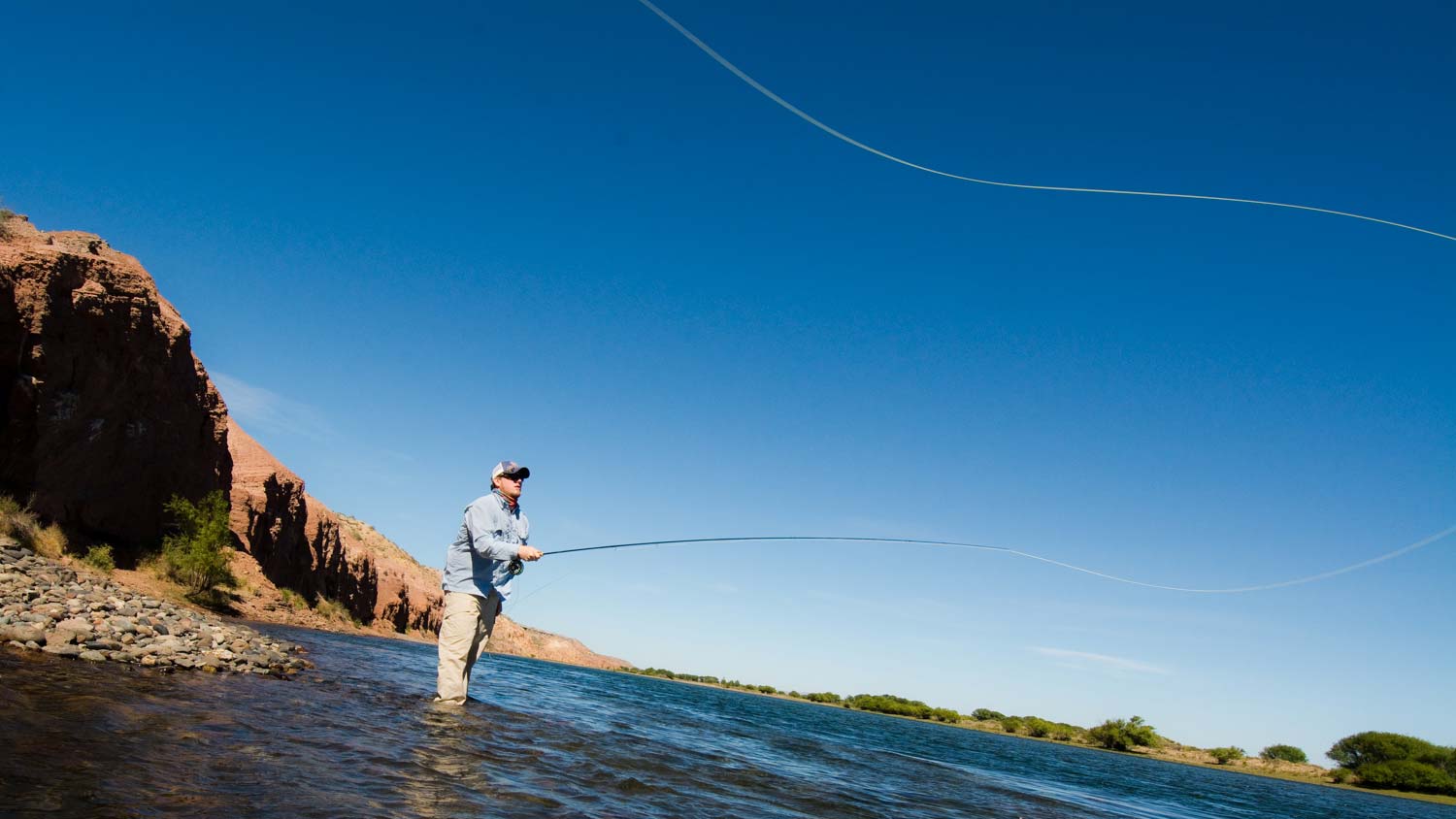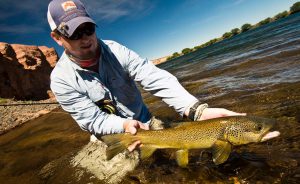
Photo by Louis Cahill
By Justin Pickett
I have never met anyone who could pick up a five-weight fly rod and make consistent, accurate fifty-foot casts without ever having prior experience with fly casting.
I used to play a ton of golf. So much so that at one point, much earlier in my youth, I could hold my own on any given course and typically shoot Par. Nothing to really brag on, but I wasn’t bad. During my time around golf courses, I never met anyone who could walk up to the 1st tee on any given course and drive the golf ball 300yds down the middle of the fairway without ever having swung a golf club before. It takes a considerable amount of learning and practice to develop the skills needed to be able to hit a golf ball with accuracy, control, and distance. And then there are the many other skills, such as putting, chipping, and bunker shots, requiring different strokes, techniques, and timing that must be practiced in order to put an entire round of eighteen holes together. For the vast majority, it’s a large investment in one’s time and effort to become a decent golfer and get the most enjoyment out of your day on the course. On a side note, I have also yet to meet anyone who enjoys looking for golf balls in the woods all day.
I have been fly fishing since the young age of ten. In my thirty-something years, I have fished way more than I ever golfed, and I have to say that I have never met anyone who could pick up a five-weight fly rod and make consistent, accurate fifty-foot casts without having prior experience with fly casting or fly fishing. Just like with golf, it takes a considerable amount of learning and practice to develop the skills needed to be able to consistently complete an accurate fly cast of any distance. Throw in roll casts, water hauls, the double haul, and reach casts and it’s starting to get a little overwhelming for the beginning angler. We haven’t even begun to talk about all the other little pieces, such as mending, hookset, fish fighting, etc. It’s a lot of info and a lot of factors that have to all come together fluidly for the angler to successfully bring fish to hand on a consistent basis, which adds to the enjoyment of our time spent on the water.
I wanted to place a focus on casting, though, because it is the first skill we need to learn in order to place a fly effectively in or on the water, and it is often that I will meet with clients at the water to find out that they have never touched a fly rod before.
…Let’s stop there for a second… There is zero wrong with this. For many, fly fishing is just an activity to strike off the list of “things to try”, and these people may or may not ever pick up a fly rod again. For others, it may not occur to them that they would benefit from casting lessons prior to hitting the water, and for some it just may not seem worth it to them to invest in the extra time and money. Whatever the reason, when these clients hit the water with me, we get it figured out and have a fun time doing it. BUT… If you want to evolve and grow as a fly angler, improving your casting is a must.
Learning how to cast takes time and lots of practice. And even after the initial learning phase, regular practice is needed in order to keep your cast in tune. I am still learning about fly casting to this day and I try to find time to practice my casting as much as possible. Lots of little things affect the fly cast and how effectively, accurately, and efficiently it delivers your fly to a target, and understanding these things is not intuitive for everyone. There are some that can pick it up rather quickly and build from there, but most new anglers need more time to nail down the mechanics and timing of a fly cast. All of these things should be solely focused on either during a lesson with an instructor, or during a dedicated time for practice, instead of on the water in the middle of your trip.
 Sure, your guide will size you up and work with what you have for the day in order to give you a shot at catching a fish or two. Is it optimal? Well, no. However, if you are going to spend your hard earned cheddar to book a guide and expect to catch fish, it would benefit everyone involved if you also spent a little time learning how to cast and make the presentations that are required for your particular trip, whether it’s freshwater or saltwater. By no means do you need to be perfect and able to throw 100ft to a dime, but having the basics down makes a huge difference. Your guide wants you to catch fish and be successful just as much as you do. Showing up with the knowledge and skills to lay down a decent fly cast vastly improves your chances of hooking up and feeling like a rock star, which makes every guide worth his or her salt crack a big smile.
Sure, your guide will size you up and work with what you have for the day in order to give you a shot at catching a fish or two. Is it optimal? Well, no. However, if you are going to spend your hard earned cheddar to book a guide and expect to catch fish, it would benefit everyone involved if you also spent a little time learning how to cast and make the presentations that are required for your particular trip, whether it’s freshwater or saltwater. By no means do you need to be perfect and able to throw 100ft to a dime, but having the basics down makes a huge difference. Your guide wants you to catch fish and be successful just as much as you do. Showing up with the knowledge and skills to lay down a decent fly cast vastly improves your chances of hooking up and feeling like a rock star, which makes every guide worth his or her salt crack a big smile.
There is a time and place to work on your casting technique.
Standing between the banks of a river, or on the bow of a skiff, with a fifty-foot cast separating you and the fish of your lifetime isn’t the time. Invest in your fly casting abilities. Whether that means ponying up for an instructor for a handful of sessions, or simply setting more time aside to practice, you will only be investing in yourself and your abilities, which will pay out in more memorable catches and enjoyable days on the water. Sounds like a great deal to me!
Justin Pickett Gink & Gasoline www.ginkandgasoline.com hookups@ginkandgasoline.com Sign Up For Our Weekly Newsletter!
I have been fly fishing for 55 years and for 45 years I wandered along with little to no practice as I felt I didn’t need it as I was doing OK with my lure fishing. Yes I did a lot of practice with all of my lure outfits and could put a practice plug in a 2 letre bucket at 50ft 90% of the time. I decided to go fly only ten years ago and did a lot of practice as one of my first trips was to Kiritimati. Kiritimati was an eye opener which convinced me I needed more practice. I also got my guide to bring me up to speed with some of my casting as we had a couple of days with 25 knot wind. I learnt a lot and caught 84 Bones and eight other species on that trip. I also made the decision to do a lot of practice. I still have a way to go, I have caught 47 saltwater and 11 freshwater species in the past 10 years and I still get out in my front yard where there are seven trees and practice for two hours a week getting flies into targets which are under overhanging tree branches. Some of my fly mates are amased at where I can get a fly when I’m out in the wind on the water. Yes I still have a long way to go in that search for excellence so I will keep practicing.
I wrote an article many years ago about fly fishing and the golf swing. In fact I had a conversation in Baltimore at Tochtermans Fish shop with Lefty, about just that, back in the mid 90s. He also felt that if you had a good golf swing you’d probably be able to fly cast with ease, and that was true with me and many I knew who played golf. The load up of the golf club and fly rod are similar, and there is hand eye coordination between the golf club and fly rod. Many on the PGA tour fly fish, like Mark O’Meara and Tiger Woods. In fact rumor is that Woods is a very good spey caster, and both fly fish for steelhead.
I love to use the golf swing to explain a lot about the fly cast. Especially for those who golf. Like you said, there are many things that are similar! I’d love to read that article. Know where I can find it? Thanks for the reply!
-JP
JP it was many moons ago over 25 years in a local magazine, but specifically what I recall was several things, a slow take away of the club and fly rod, loading of the fly rod and club which is the shaft and the rod itself, and then a increasing speed of the forward cast and increasing downward descending hit of the golf club. Both of these require hand/eye coordination, without which you get tailing loops, dropped casts, or a poor swing of the golf club. Too fast a swing you may hook the ball, too slow a fade, similarly allowing the cast to be too fast or slow you won’t load the rod properly, it’s certainly a timing issue. Anyway I may do another article, maybe with some demonstrations, there are so many similarities more then dissimilarities.
AMEN Brother! This is our 20 anniversary of singing that toon and trying to help those who are smart enough to prepare for their trip.
Pingback: Why You Should Invest In Your Casting | Latest Fishing Blogs Posts